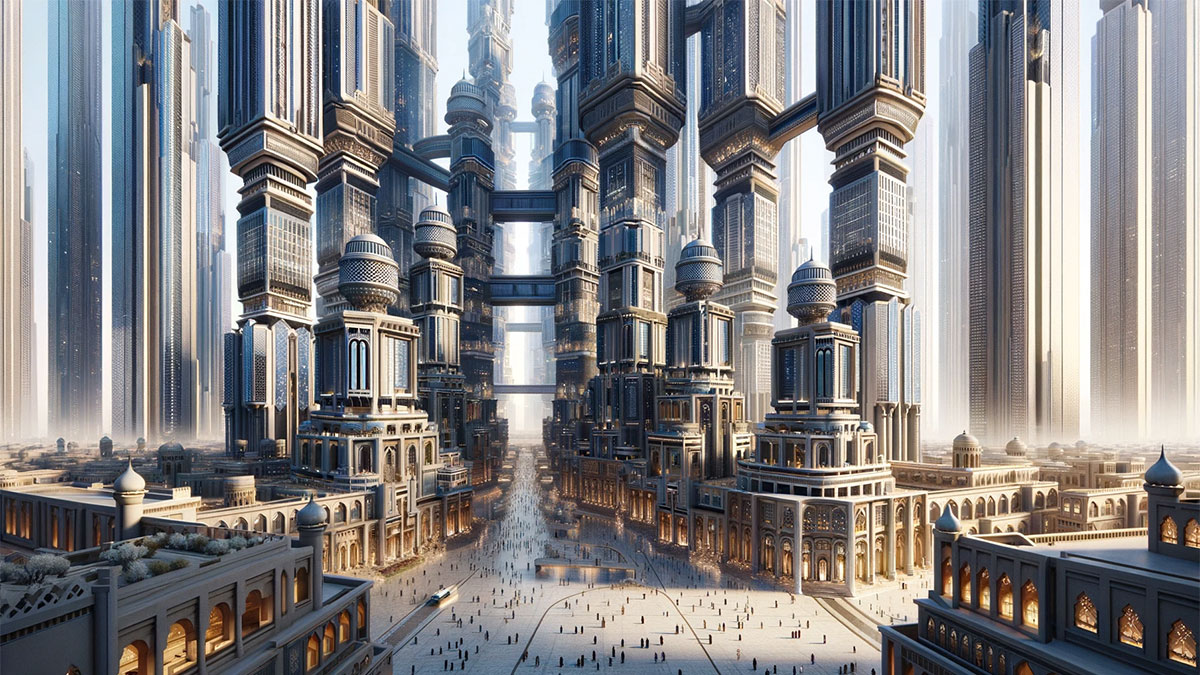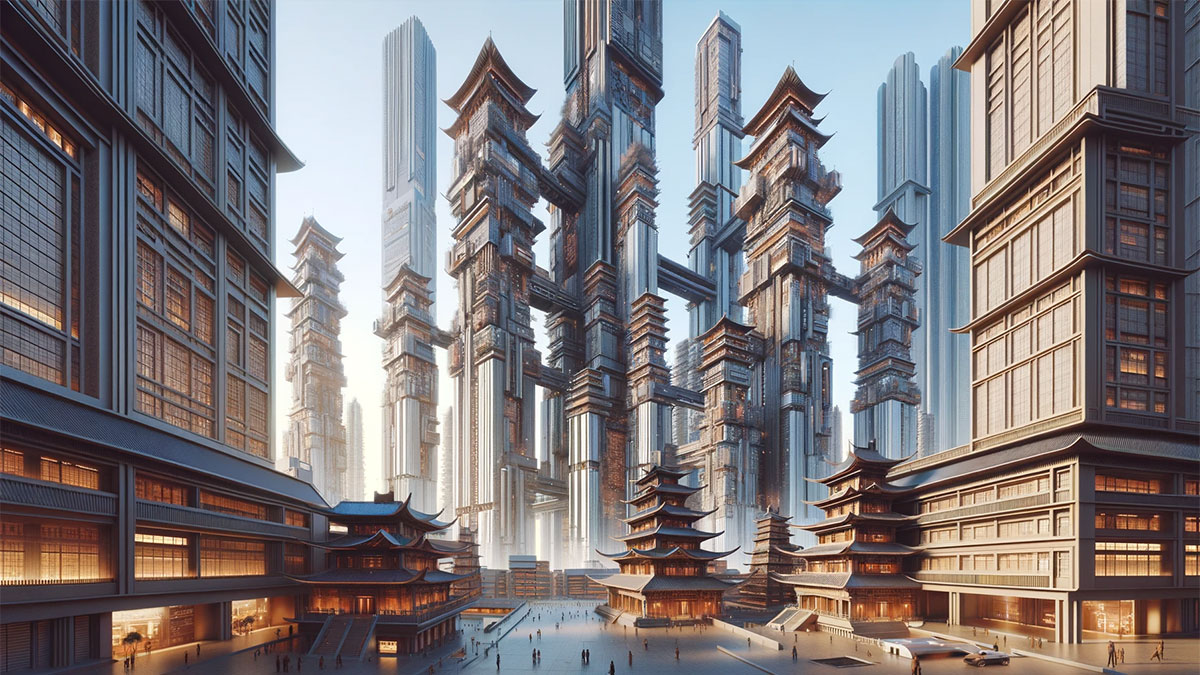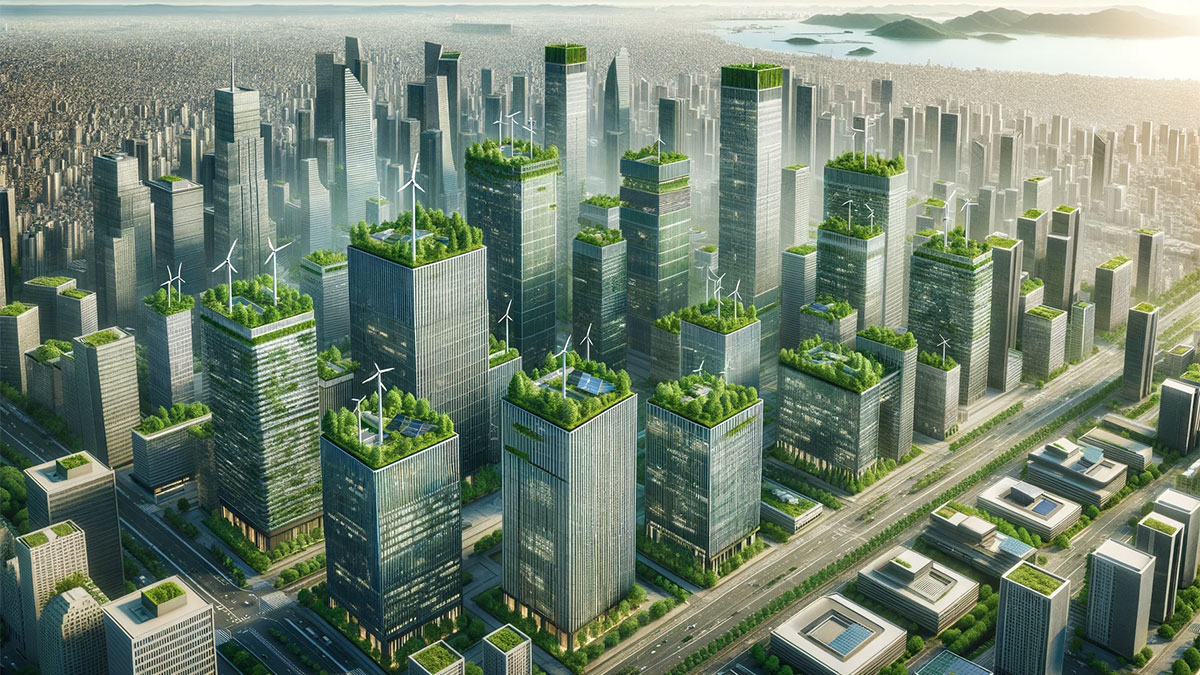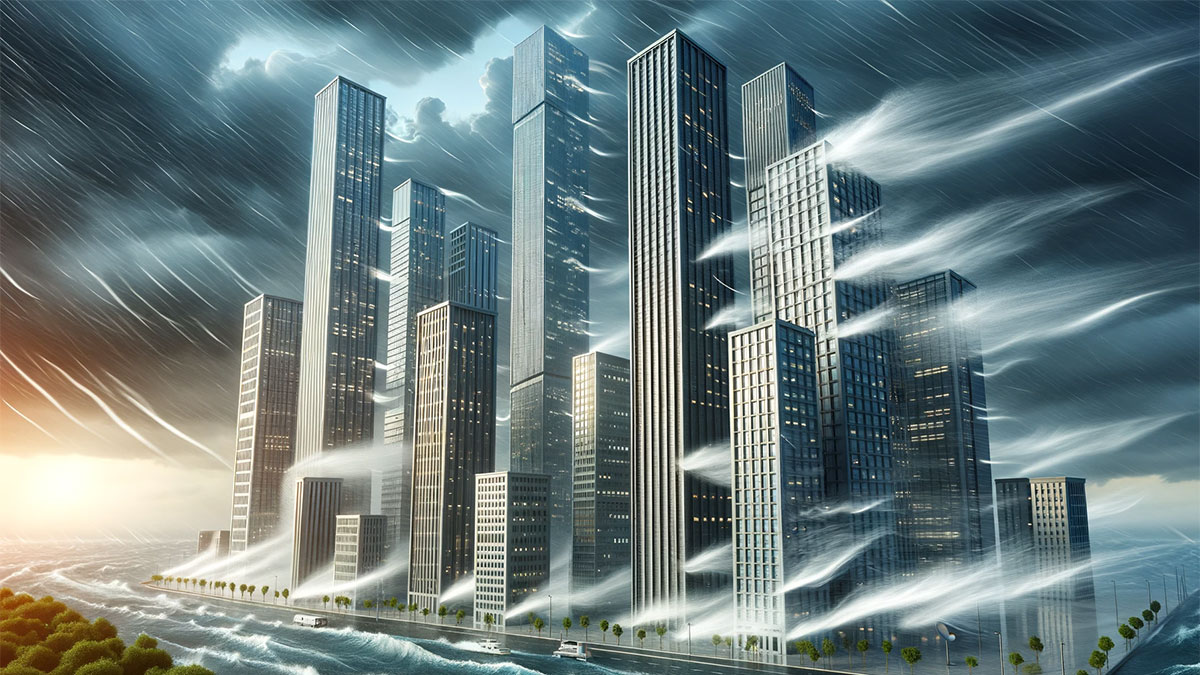Skyscrapers have always symbolized human progress and innovation in architecture and engineering. As urbanization intensifies, cities are becoming denser and taller, making skyscrapers more common. A pivotal question arises: how tall will skyscrapers be in the future?
The height of skyscrapers has steadily increased over the past century, with the Burj Khalifa in Dubai currently standing as the tallest at 2,717 feet (828 meters). With technological and engineering advances continually pushing the limits, it’s possible that future skyscrapers could reach heights of 4,000 feet.
Despite the race to build the tallest buildings, these developments present new challenges and risks. The taller a structure, the more it contends with wind, seismic activity, and other environmental factors. Moreover, constructing these giants requires significant resources and energy, potentially impacting the environment negatively.
Key Takeaways
- Future skyscrapers could potentially reach heights of 4,000 feet or more, propelled by advancements in technology and engineering.
- The evolution of skyscraper design emphasizes a crucial balance between height, sustainability, and safety in urban development.
- Constructing taller buildings introduces heightened challenges with wind, seismic activity, and increased environmental impact.
Historical Evolution of Skyscrapers
Skyscrapers have come a long way since the first steel-framed skyscraper, the Home Insurance Building in Chicago, was built in 1885. In this section, we’ll take a look at the historical evolution of skyscrapers, from the Empire State Building to the Burj Khalifa.
From Empire State to Burj Khalifa
The Empire State Building, completed in 1931, was the tallest building in the world until 1971. It stood at 1,454 feet (443.2 meters) tall and was the first building to have more than 100 floors. The building was designed by William F. Lamb of the architectural firm Shreve, Lamb and Harmon, and was constructed in just 13 months.
The Petronas Towers in Kuala Lumpur, Malaysia, were completed in 1998 and held the title of the world’s tallest buildings until 2004. The towers stand at 1,483 feet (452 meters) tall and were designed by Argentine architect Cesar Pelli.
The Burj Khalifa in Dubai, completed in 2010, is currently the tallest building in the world, standing at 2,717 feet (828 meters) tall. The building was designed by Adrian Smith of the architectural firm Skidmore, Owings & Merrill, and was constructed in just over five years.
Rise of Supertall Structures
The One World Trade Center in New York City, completed in 2014, stands at 1,776 feet (541 meters) tall and is the tallest building in the Western Hemisphere. The building was designed by David Childs of the architectural firm Skidmore, Owings & Merrill and was constructed on the site of the original World Trade Center.
The Shanghai Tower in China, completed in 2015, stands at 2,073 feet (632 meters) tall and is the second-tallest building in the world. The building was designed by Jun Xia of the architectural firm Gensler and was constructed in just over six years.
As technology continues to advance, we’ll likely see even taller skyscrapers in the future. There are also concerns about the environmental impact of these structures and their safety during natural disasters. Nonetheless, skyscrapers remain a symbol of human achievement and architectural excellence.
Technological Advancements in Construction
Innovative Materials and Methods
As skyscrapers continue to reach new heights, innovative materials and construction methods are being developed to accommodate these structures. One such material is ultra-high-performance concrete (UHPC), which is stronger and more durable than traditional concrete. UHPC can support taller and thinner structures, allowing architects to design buildings with more complex shapes and unique features.
Another method that is gaining popularity is modular construction. This involves constructing sections of a building off-site and then assembling them on-site. Modular construction can save time and money, while also reducing waste and minimizing disruption to the surrounding area.
Elevator Technologies for Taller Buildings
As buildings get taller, elevators must be able to transport people and goods quickly and efficiently. One technology that is being developed is the rope-free elevator, which uses magnetic levitation to move the elevator car up and down the shaft. This technology can increase the speed and capacity of elevators, while also reducing energy consumption.
Another development is the double-decker elevator, which can transport twice as many people as a traditional elevator. These elevators have two levels within the same shaft, allowing for more efficient use of space and reducing the number of shafts needed in a building.
Overall, technological advancements in construction and elevator technologies are enabling architects and engineers to design taller and more complex buildings than ever before. As these technologies continue to evolve, we will likely see even taller and more innovative structures in the future.
Architectural Design and Aesthetics
Influence of Iconic Architects
The future of skyscrapers’ height is not only about functionality but also about architectural design and aesthetics. Iconic architects such as Adrian Smith, Zaha Hadid, Frank Gehry, Herzog & de Meuron, Kohn Pedersen Fox, Adrian Smith + Gordon Gill, Bjarke Ingel’s, and Sou Fujimoto Architects have played a significant role in shaping the future of skyscrapers’ design.
Adrian Smith, for instance, is known for designing the Burj Khalifa, the world’s tallest building. Zaha Hadid has designed the Wangjing SOHO in Beijing, which features two towers connected by a flowing, curvaceous structure. Frank Gehry’s Walt Disney Concert Hall in Los Angeles is known for its striking stainless steel exterior. Herzog & de Meuron designed the 56 Leonard Street building in New York City, which features a unique Jenga-like design.
Aesthetic Pollution vs. Iconic Landmarks
There’s been a growing concern about the impact of skyscrapers on the urban landscape. Some argue that the proliferation of skyscrapers is leading to “aesthetic pollution,” where the skyline is dominated by generic glass towers that lack character and charm.
On the other hand, others argue that skyscrapers can become iconic landmarks that define a city’s identity. For instance, the Empire State Building in New York City is a beloved landmark that has become a symbol of the city itself.
The future of skyscrapers is not just about how tall they will be, but also about their design and aesthetic impact on the urban landscape. Iconic architects have a significant role to play in shaping the future of skyscraper design, but there is also a need to balance aesthetic considerations with the need for functionality and sustainability.
Global Skyscraper Projects and Hotspots
As urbanization continues to accelerate, skyscrapers are becoming taller and more numerous. The race to build the tallest building in the world is a never-ending competition, with new projects constantly being announced. In this section, we will take a look at some of the current hotspots for skyscraper construction around the world.
Asia’s Dominance in Skyscraper Construction
Asia is currently the global leader in skyscraper construction. China, in particular, has been a hotbed of activity, with cities like Shenzhen leading the way. Shenzhen is home to the new financial district, which is currently under construction and will feature several new skyscrapers, including the Ping An Finance Center, which is already the fourth-tallest building in the world.
Other notable projects in Asia include the Merdeka 118 in Kuala Lumpur, which will be the tallest building in Southeast Asia when completed, and the Jeddah Tower in Saudi Arabia, which will be the first building to reach a height of one kilometer.
Emerging Skyscraper Cities in North America
While Asia may be leading the way in skyscraper construction, North America is not far behind. New York City is currently in the midst of a building boom, with projects like Hudson Yards and the Chicago River Tower set to transform the city’s skyline.
Miami is also emerging as a new hotspot for skyscrapers, with several new projects in the works, including the One Bayfront Plaza, which will be the tallest building in Florida when completed.
Canada is also getting in on the action, with Toronto and Monterrey both seeing a surge in skyscrapers being built in recent years. The 1200 Bay Street project in Toronto is set to be one of the tallest buildings in the city, while the new Bay Street financial district in Monterrey will feature several new skyscrapers.
European Skyscrapers: Blending Tradition with Modernity
While Europe may not be known for its skyscrapers, several cities are starting to embrace tall buildings as a way to accommodate growing populations. London, in particular, has seen a surge in new skyscrapers in recent years, with iconic buildings like The Shard and The Gherkin transforming the city’s skyline.
Other notable projects in Europe include the new Paris La Defense Arena, which will be the largest indoor arena in Europe when completed, and the Varso Tower in Warsaw, which will be the tallest building in Poland.
As the world’s population continues to grow and urbanization accelerates, skyscrapers will continue to play an important role in accommodating the needs of cities around the world. With new projects constantly being announced, it’s clear that the race to build the tallest building in the world is far from over.
Economic and Urban Development Factors
Skyscrapers are often seen as symbols of economic power and development. Their construction is influenced by a variety of economic and urban development factors. This section explores two such factors: the impact of high land values on skyscraper height and the role of skyscrapers as symbols of economic power.
Impact of High Land Values on Skyscraper Height
One of the key factors influencing the height of skyscrapers is the cost of land. In cities with high land values, developers are more likely to build taller buildings to maximize their return on investment. This is particularly true in cities like New York City, where land values are among the highest in the world.
The economic downturn caused by the global pandemic has had a significant impact on the construction of skyscrapers. With many businesses struggling to stay afloat, demand for office space has decreased, leading to a slowdown in the construction of new skyscrapers.
The vaccination rate has also played a role in the construction of skyscrapers. With many people still working from home, demand for office space has decreased, leading to a slowdown in the building of new skyscrapers.
Skyscrapers as Symbols of Economic Power
Skyscrapers are often seen as symbols of economic power and development. They are often built in cities that are striving to establish themselves as global economic hubs. For example, the building of the Burj Khalifa in Dubai was part of a larger effort to establish Dubai as a global financial center.
The construction of skyscrapers can also be seen as a way for cities to compete with one another. For example, the building of the Petronas Towers in Kuala Lumpur was seen as a way for Malaysia to compete with neighboring Singapore.
The height of skyscrapers is influenced by a variety of economic and urban development factors, including high land values and the desire to establish a city as a global economic hub. The global pandemic and vaccination rate have also had a significant impact on the construction of skyscrapers.
Environmental and Social Considerations
Sustainable Design and Green Skyscrapers
As the world’s population continues to grow, skyscrapers are becoming an increasingly popular solution to the problem of limited space in urban areas. The construction and operation of these buildings can have a significant impact on the environment and local communities. To address these concerns, architects and engineers are increasingly designing skyscrapers with sustainability in mind.
One approach to sustainable design is to incorporate green spaces into the building’s design. Rooftop gardens and green walls not only improve air quality and provide habitat for wildlife but also help to reduce the urban heat island effect.
Other sustainable design features include energy-efficient lighting and HVAC systems, as well as the use of renewable energy sources such as solar panels and wind turbines.
Urban Life and Public Spaces
While skyscrapers can provide much-needed space for housing, offices, and other functions, they can also hurt urban life and public spaces. High-rise buildings can create shadows that make streets and parks feel dark and unwelcoming, while also disrupting the natural flow of air and light.
To mitigate these effects, architects and urban planners are increasingly designing buildings with public spaces in mind. This can include creating open plazas or green spaces at the base of the building, as well as incorporating public amenities such as museums, clubs, and other cultural institutions. In addition, many cities are investing in mass transit connectivity to make it easier for people to move around the city without relying on cars.
Overall, while skyscrapers offer many benefits in terms of space and functionality, it is important to consider the environmental and social impact of these buildings. By designing buildings with sustainability and public spaces in mind, architects and urban planners can help to create a more livable and sustainable urban environment.
How Tall Skyscrapers Could Get in the Future
The world’s tallest skyscrapers have been getting taller and taller over the years, with the current record holder being the Burj Khalifa in Dubai, which stands at 828 meters tall. Experts believe that skyscrapers could reach even greater heights in the future.
The Race for the World’s Tallest Skyscraper
There is constant competition among architects and developers to build the world’s tallest skyscraper. The title of the world’s tallest building is a coveted one, and it can bring a lot of prestige and attention to a city or a developer.
Currently, the Jeddah Tower in Saudi Arabia is set to become the world’s tallest building, with a projected height of 1 kilometer. There are already plans for even taller buildings, such as the proposed Sky Mile Tower in Tokyo, which would be 1.6 kilometers tall.
Post-Covid World: The Impact on Skyscraper Design
The Covid-19 pandemic has brought about many changes in the way we live and work, and it is expected to have an impact on the design of skyscrapers as well. One of the biggest changes could be a shift towards more outdoor areas in skyscrapers.
As people have spent more time indoors during the pandemic, there has been a growing appreciation for outdoor spaces. Skyscraper developers may look to incorporate more gardens, terraces, and other outdoor spaces into their designs to provide tenants with a connection to nature and fresh air.
Another potential impact of the pandemic could be a change in the office market. With more people working from home, there may be less demand for traditional office spaces in skyscrapers. Developers may need to adapt their designs to include more flexible workspaces and amenities that cater to remote workers.
Overall, the future of skyscrapers is likely to be shaped by a combination of factors, including technological advancements, environmental concerns, and changing societal needs. While it is difficult to predict exactly how tall skyscrapers will get, it is clear that they will continue to be a symbol of human achievement and progress.
Challenges and Innovations in Skyscraper Engineering
Structural Integrity and Wind Resistance
The building of skyscrapers has always been a challenge due to the need for structural integrity and wind resistance. The collapse of the Twin Towers on 9/11 highlighted the importance of safety in skyscraper design. Structural engineers such as Kamran Moazami have since been working on innovative solutions to prevent similar disasters from happening in the future.
One of the key innovations in skyscraper engineering has been the use of advanced materials such as high-strength concrete and steel. These materials provide the necessary strength and durability to withstand the forces of nature and ensure the safety of occupants.
In addition to materials, the shape and design of skyscrapers play a critical role in wind resistance. Engineers use computer simulations to model the behavior of buildings in different wind conditions and optimize their designs accordingly. This has led to the development of unique shapes such as the tapered design of the Burj Khalifa in Dubai, which reduces wind loads and enhances stability.
The Role of Engineering Firms in Future Skyscraper Development
Engineering firms such as WSP play a crucial role in the development of future skyscrapers. These firms provide expertise in structural design, wind engineering, and other key areas to ensure the safety and functionality of buildings.
However, the development of skyscrapers is not without controversy. Some have criticized the construction of very tall buildings as “vanity projects” that serve no practical purpose and pose significant mortality risks in the event of a disaster.
As such, engineering firms must balance the need for innovation and progress with the responsibility to ensure safety and sustainability. This requires a deep understanding of the latest technologies and materials, as well as a commitment to ethical and responsible design principles.
It’s going to be up to engineers and designers to overcome the challenges of structural integrity and wind resistance while balancing the need for innovation with safety and sustainability. With continued innovation and collaboration, we can expect to see even taller and more impressive skyscrapers in the years to come.




